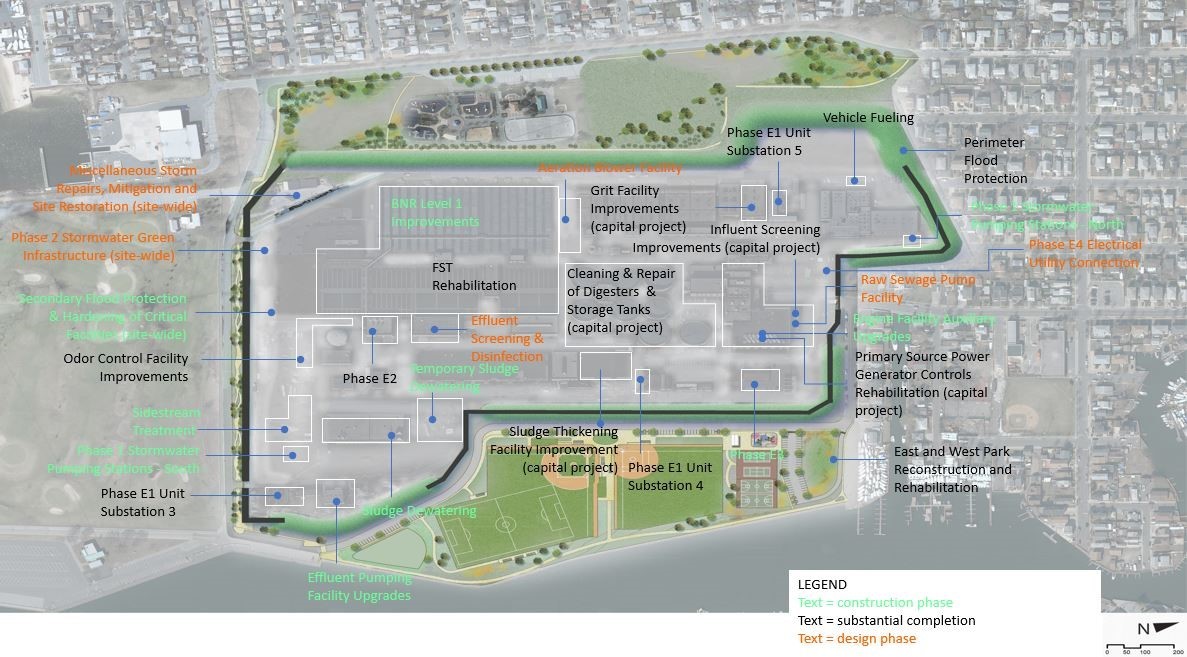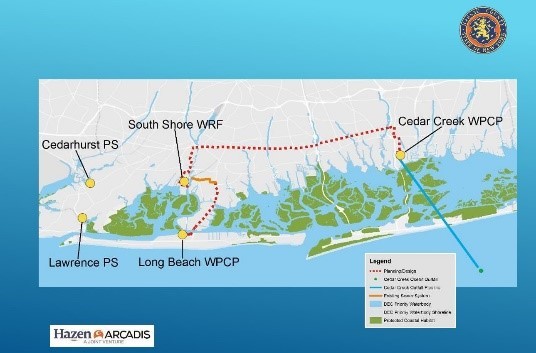In this month’s issue we highlight the ongoing nitrogen reduction initiatives lead by our LINAP partners in Nassau County.
County Subwatershed PlanningThe Nassau County Subwatershed Planning work continues to progress and is expected to be completed in 2019. When complete, the plan will help to determine how much nitrogen is entering the groundwater from different sources, e.g. wastewater, fertilizer, stormwater and atmospheric deposition. This important effort is being led by Stony Brook University’s School of Marine and Atmospheric Sciences in partnership with the county, NYS Department of Environmental Conservation and the Long Island Regional Planning Council. A Nitrogen Load Model (NLM), which is central to this work, has been completed and nitrogen loads for each of the county’s 13 subwatersheds have been calculated. The hydrodynamic modeling of the subwatersheds, which is nearing completion, will generate information that will help determine the priority level for the nitrogen present in the subwatersheds and how much nitrogen will need to be removed to achieve water quality goals. The modeling will also inform which nitrogen load reduction strategies to deploy. Suffolk County is also developing a subwatershed plan using the NLM model and it is expected to be completed later in the year. South Shore Water Reclamation Facility ProjectsReconstruction and Resiliency UpgradesNassau County continues to conduct major reconstruction and resiliency upgrades to the South Shore Water Reclamation Facility (formerly known as the Bay Park Sewage Treatment Plant) which was severely damaged by Superstorm Sandy. The regional vision for the facility – operated by Suez through a public-private partnership with the county – includes ocean outfall discharge (of treated effluent), consolidation of local waste water treatment plants and nitrogen removal. To date many enhancements have been completed including: construction of perimeter flood protection, rehabilitation of final settling tanks, the completion of 22 pump stations, the cleaning and repairing of digesters, as well as improvements to sludge thickening facilities, grit facilities, and influent screening. Work currently underway includes: 7 additional pump stations, sludge dewatering improvements and upgrades to the effluent pumping facility, storm water pump stations and construction of a new force main in the Village of Hempstead. As part of the upgrade effort, the County has also commenced two projects designed to reduce the nitrogen concentration in wastewater effluent discharged from the facility. The first project, Biological Nutrient Removal (BNR), has been in construction since the summer of 2017. Modelling studies indicate that BNR should reduce nitrogen from 35 mg/L to a target range of 13 mg/L. The second nitrogen reduction project is a Deammonification (Sidestream) Treatment Process. The design phase has been completed and the project is currently out to bid. It is anticipated that this technology will remove ammonia-nitrogen by 90 percent or greater and 80 percent or greater of total nitrogen.
Brian Schneider, Deputy County Executive for Parks and Public Works, LINAP Update, May 8, 2018 Effluent Diversion ProjectTreated wastewater for the South Shore Water Reclamation Facility (formerly Bay Park Sewage Treatment Plant) discharges into Reynolds Channel and is one of the causes of long-term water quality problems in the Western Bays. After reviewing different options to divert the treated wastewater discharge to the ocean – including a new ocean outfall off Long Beach Island – the County focused on a plan that would reroute treated effluent from the Bay Park plant to an existing ocean outfall at the Cedar Creek Wastewater Treatment Plant, by making use of an abandoned county-owned aqueduct located under Sunrise Highway. An inspection and assessment of the historic aqueduct found it to be in good condition and suitable for rehabilitation for this purpose. The next step is to restore the section of the aqueduct that will be used in this innovative project. The County is partnering with the DEC to implement the project in an expeditious manner. The project will prevent the discharge of 19 billion gallons of treated sewage into Long Island’s Western Bays each year, thereby eliminating harmful nitrogen pollution which will help rejuvenate vital marshlands that protect coastal communities from storm-induced waves.
City of Long Beach Wastewater Diversion to the South Shore Water Reclamation FacilityIn 2017, the City of Long Beach entered into a Consent Order with DEC committing to the planning, design, construction, and operation of a project to divert wastewater from the Long Beach Wastewater Treatment Plant (WWTP) to the South Shore Water Reclamation Facility for treatment and discharge. The Long Beach WWTP would be converted to a pump station to enable this change. Currently, Nassau County is developing an Inter-Municipal Agreement with the City of Long Beach which will create the framework for the pump station conversion project. This project, in conjunction with the South Shore Water Reclamation Facility Effluent Diversion Project (discussed above), would remove approximately 60 million gallons per day of wastewater effluent containing over 15 tons of pollutants from Reynolds Channel and the Western Bays. Point Lookout Sewer StudyOn December 13, 2017, as part of the Long Island Regional Economic Development Award, Nassau County was awarded $2 million to plan, design and construct sewer infrastructure for Point Lookout to connect to the existing wastewater treatment plant in Long Beach. In May 2018, the Nassau County Legislature approved $1 million be used for a sewering feasibility study. A Request for Proposals (RFP) will be developed and is slated for released in late 2019. Nassau County Septic Improvement ProgramThe Clean Water Infrastructure Act of 2017 established the State Septic System Replacement Fund and allocated $75 million to support a multi-year effort to replace aging septic systems in priority areas across New York State. Nassau County was awarded $1 million from this fund to initiate a septic improvement program. In 2018, the County officially entered into an agreement with the State to use this funding to provide single family households with 50 percent of replacement costs, up to $10,000 for failing septic systems. These systems, similar to Suffolk County’s Reclaim Our Waters Program, would need to reduce nitrogen effluent concentrations by 30 percent or more. The County’s intention is to launch the program in 2019 with a public announcement to residents residing in the geographic areas that would be eligible for applying for a grant. Western Bays Public ForumCitizens Campaign for the Environment, The Nature Conservancy, and Operation SPLASH are hosting a public forum on the ongoing work at the South Shore Water Reclamation Facility (formerly Bay Park Sewage Treatment Plant), the connection to an ocean outfall pipe at the Cedar Creek Sewage Treatment Plant and water quality in the Western Bays. Date: Tuesday, April 2nd For more LINAP news visit the LINAP webpage. |
Footer
Contact
STAY INFORMED
Enter your email address to receive email updates from the LIRPC:





